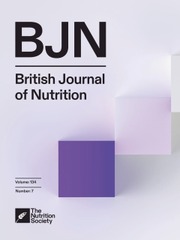Crossref Citations
This article has been cited by the following publications. This list is generated based on data provided by
Crossref.
Liggins, Jason
Bluck, Leslie J.C
Runswick, Shirley
Atkinson, Charlotte
Coward, W.Andy
and
Bingham, Sheila A
2000.
Daidzein and genistein content of fruits and nuts.
The Journal of Nutritional Biochemistry,
Vol. 11,
Issue. 6,
p.
326.
Belcher, Scott M.
and
Zsarnovszky, Attila
2001.
Estrogenic Actions in the Brain: Estrogen, Phytoestrogens, and Rapid Intracellular Signaling Mechanisms.
The Journal of Pharmacology and Experimental Therapeutics,
Vol. 299,
Issue. 2,
p.
408.
Messina, Mark J.
and
Loprinzi, Charles L.
2001.
Soy for Breast Cancer Survivors: A Critical Review of the Literature.
The Journal of Nutrition,
Vol. 131,
Issue. 11,
p.
3095S.
2001.
Abstracts of Original Communications (University of Sheffield, Sheffield, UK. 10–12 July 2001).
Proceedings of the Nutrition Society,
Vol. 60,
Issue. 4b,
p.
171A.
2001.
Abstracts of Original Communications (University of Dundee, Dundee, UK. 28–29 March 2001).
Proceedings of the Nutrition Society,
Vol. 60,
Issue. 4b,
p.
135A.
Atkinson, Charlotte
and
Bingham, Sheila A
2001.
Mammographic breast density as a biomarker of effects of isoflavones on the female breast.
Breast Cancer Research,
Vol. 4,
Issue. 1,
Boker, Lital Keinan
Van der Schouw, Yvonne T.
De Kleijn, Miriam J.J.
Jacques, Paul F.
Grobbee, Diederick E.
and
Peeters, Petra H.M.
2002.
Intake of Dietary Phytoestrogens by Dutch Women.
The Journal of Nutrition,
Vol. 132,
Issue. 6,
p.
1319.
Wiseman, Helen
Casey, Karen
Clarke, Don B.
Barnes, Karen A.
and
Bowey, Elizabeth
2002.
Isoflavone Aglycon and Glucoconjugate Content of High- and Low-Soy U.K. Foods Used in Nutritional Studies.
Journal of Agricultural and Food Chemistry,
Vol. 50,
Issue. 6,
p.
1404.
Adlercreutz, Herman
Mazur, Witold
Heinonen, Satu-Maarit
and
Stumpf, Katariina
2002.
Breast Cancer.
p.
527.
Wilkinson, A.P
Wähälä, K
and
Williamson, G
2002.
Identification and quantification of polyphenol phytoestrogens in foods and human biological fluids.
Journal of Chromatography B,
Vol. 777,
Issue. 1-2,
p.
93.
Kushad, Mosbah M.
Masiunas, John
Eastman, Kathy
Kalt, Wilhelmina
and
Smith, Mary A. L.
2002.
Horticultural Reviews.
p.
125.
Messina, Mark
Hasler, Clare
Kundrat, Susan
and
Gugger, Eric
2002.
Phytoestrogens and Health.
Liggins, J
Mulligan, A
Runswick, S
and
Bingham, SA
2002.
Daidzein and genistein content of cereals.
European Journal of Clinical Nutrition,
Vol. 56,
Issue. 10,
p.
961.
Bluck, Leslie J. C.
Jones, Kerry S.
Thomas, Jane
Liggins, Jason
Harding, Marilyn
Bingham, Sheila A.
and
Coward, W. Andrew
2002.
Quantitative analysis using gas chromatography/combustion/isotope ratio mass spectrometry and standard addition of intrinsically labelled standards (SAIL) –application to isoflavones in foods.
Rapid Communications in Mass Spectrometry,
Vol. 16,
Issue. 24,
p.
2249.
Murphy, Patricia A
and
Hendrich, Suzanne
2002.
Vol. 44,
Issue. ,
p.
195.
Kao, T. H.
and
Chen, B. H.
2002.
An improved method for determination of isoflavones in soybean powder by liquid chromatography.
Chromatographia,
Vol. 56,
Issue. 7-8,
p.
423.
Degen, Gisela H.
Janning, Petra
Diel, Patrick
and
Bolt, Hermann M.
2002.
Estrogenic isoflavones in rodent diets.
Toxicology Letters,
Vol. 128,
Issue. 1-3,
p.
145.
Champ, Martine M.-J.
2002.
Non-nutrient bioactive substances of pulses.
British Journal of Nutrition,
Vol. 88,
Issue. S3,
p.
307.
Kiely, Mairead
Faughnan, Marian
Wähälä, Kristiina
Brants, Henny
and
Mulligan, Angela
2003.
Phyto-oestrogen levels in foods: the design and construction of the VENUS database.
British Journal of Nutrition,
Vol. 89,
Issue. S1,
p.
S19.
Grace, Philip B
Taylor, James I
Botting, Nigel P
Fryatt, Tara
Oldfield, Mark F
and
Bingham, Sheila A
2003.
Quantification of isoflavones and lignans in urine using gas chromatography/mass spectrometry.
Analytical Biochemistry,
Vol. 315,
Issue. 1,
p.
114.

